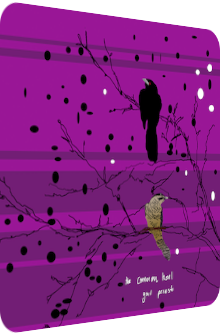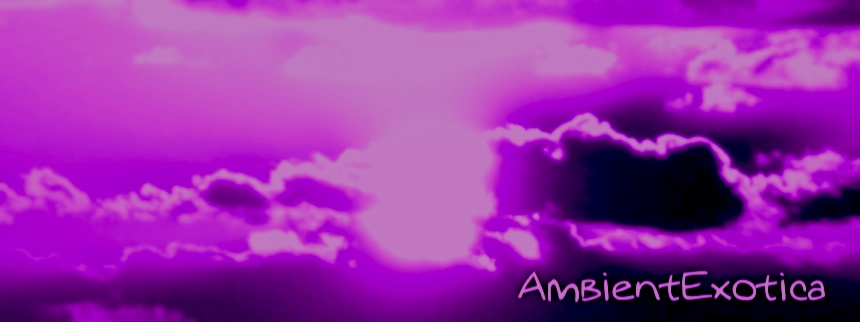
Gail Priest
The Common Koel
2013
The Common Koel by the Sydney-based writer and sound artist Gail Priest marks the eighth installment in the Birds Of A Feather series of releases on Kate Carr’s Flaming Pines label. Released in June 2013 in a limited edition of 100 three-inch CD’s, Priest fathoms out skulduggeries and chicaneries one would not have expected in the series heretofore. To most parts of the worlds, a koel does not mean anything in particular, but rest assured that it is a largely unwanted species of birds that is impossible to avoid in Sydney and its surroundings as well as in New Zealand. It is a brood parasite that lays its eggs in other birds’ nests. Well, what gives, this surely serves some sort of purpose, and after all, nature is cruel, right? Turns out that this cuckoo also has a much more nerve-racking habit. It chirps in an unparalleled two-tone way, and these mating cries are earthshaking and clarion-klaxon, waking up inculpable townsfolk in the early morning, preventing the much needed sleep time and again. Is this a bird that deserves a long-form composition of 16+ minutes? Oh yes, and according to Kate Carr’s press blurb, Gail Priest watched the bird’s behavior very closely and transferred many of its characteristics into her song. Says Priest: "Taking lessons from the bird, the resulting piece explores infiltration, imitation and subjugation as strategies." And indeed, the bird infiltrates the living daylights out of its own song, quite literally so, for The Common Koel is a very dark piece, sources of light are very rare. And the concept of imitation is an eminently portentous one as it turns out. The artist does not mention what instruments were used for the creation of this piece, but I presume that the bass guitar is a weighty part of the big picture, with gong-like wind chime devices appearing in the latter half. Without giving away too much in the opening paragraph, Gail Priest observes her self-imposed subject from a masochistic viewpoint. Those who hate the bird with a passion should give this record a chance, as strange a remark this may seem. Some reasons and insights are given below.
Stormy figments, airflow apparitions and sonic protuberances: The Common Koel does not exactly embrace the listening subject with amicable surroundings or a benign buoyancy. The nocturnal wasteland points back to the front artwork, but is highly intriguing due to its well-balanced polymorphous base frame. The synthetic wind gust oscillates turbulently, comes in an ashen hue and emanates a nightly aura. Adjacent bass drones cut through the curiously tense atmosphere with their bone-crushing midrange depth and sanguine staint. Elasticized AM frequencies wobble in serpentine directions, not following any pattern, flowing freely and capriciously. After two minutes, the first striking incident happens, now truly pointing out the connection to the title and series Gail Priest’s composition is part of: the unique, one of a kind screech-like chirps of a koel dash through the primordial soup of the quavering quagmire. Like blazing lightning bolts, their signal effect is unmistakeably linked to the New Zealand parasite. Apart from its prominent inclusion, the vaulted soundscape continues to shine in the miasmatic sense. Analogue-like plateaus and drone streams create a strangely motionless fluxion. There is a sense of progression, both in terms of watching the seconds fly by and the ever-changing shapeshifting micro-structures of the textures, but somehow sinews and virulence reign, anesthetize the listener to such a degree that he or she is still perfectly aware of the lilac-colored concoction, but also bedazzled due to the omission of any mellifluous element. There is a description for such music: Dark Ambient.
After more than four minutes, cavalcades of eerie dark matter pads and bass guitar runlets later, The Common Koel enters a specifically appealing stage, terrifying for every denizen who has to suffer from the parasite’s appearance, but all the more satisfying for listeners who only encounter the koel via a push of a button, i.e. by playing the Sydneysider’s composition. What unfolds in the next few minutes could be described as psychedelic and purposefully apocryphal. Claustrophobia and horror can potentially ensue, but I for one am strangely drawn to the following happening: the unique chirps of the scapegrace are isolated from the drone structures, with only the field recording in place. So far, so good. However, the chirping is then looped, multiplied and sees its tempo increased. This death spiral is a pandemonium (or panopticon?) par excellence, and as sudden as this maelstrom built up, it is instantly over, leading to another koel chirping in front of a pitch-black background. No additional filter is used, only the largely unprocessed screams of the hellion. This phase depends on the listener’s inclination more than any other koel-charged vignette. If the screams cannot be tolerated, there is little to make the concept digestible, to poeticize the two-tone tomfoolery, to decrease desperate eruptions or outcries. Maybe mockery lessens the anger, and so it happens that Priest underpins the bird’s signature feature with a downpitched, enormously demonic afterglow. The alienation only grows, but there are traces of humor in here.
After the exclusivity the bird enjoyed in that phase, the return of more musical elements is on the agenda. The frequency spectrum is widened with the help of glacial bit-crushed Glitch remnants, digital rockfall bleeps and 8-bit burps in the distance, the latter of which contain only two tones, and blimey, it is indeed these two tones. The koel gets tared and feathered, eureka! Its brutish complexion oozes out of the moist Glitch coils, its birdoid remnants are still graspable somewhere in-between the alloy, but that beast gets what it deserves, at least momentarily so. Animal rights activists, don't protest: Disney did it first. The increase of the frizzling frequencies even manages to temporarily suggest a stardust-coated forest scenery with chirring crickets, but before one gets hold of this illusion, genuine chimes appear. Gail Priest either plays a mallet instrument or large wind chimes, but whatever the source may be, the result is a wonderful fleeting visit to dignified-mystical New Age realms. The decay and sustain of the bells coalesces with the nonentity, the koel is still present, though less mutinous. The seemingly alatoric bell layers then form a dark, almost ritualistic loop whose perceived cavity is grim and baneful. With no traces of sunlight in sight, the only source of illumination consists of… yep, two tones. The koel is back, its trademark mating call is played on an antediluvian Rave organ which is naturally based on Gail Priest’s filtering technique. A cyberspace of insanity is built bit by bit, terrifically sinister synth-like strings waft in the background, and whatever the current pattern or surface of them is, beyond the shrubbery of textures the koel rests. The finale is incredibly weird, paganism is all over this piece, prolonged chirps sound like the abused souls of the bird, a dusky, crepuscular recalcitrance reigns, and once these structures fade out, this must be the end. Or is it?
Simply writing that Gail Priest’s The Common Koel is haunting would be an understatement. It is still not clear to me who is ridiculed or tortured by this violet-colored piece. Is the parasite the victim and gets what it deserves, or is the listener put to the test? Regardless of whether a definitive answer is even needed, the 16+ minutes of this piece are joyful, I kid you not. Potential harshness, perceived acidity and grim endeavors are spread all over the duration, but they are really just that: potential. Be it the vigorous bass guitar sine waves in the opening phase, the nothingness of the background paired with the spiraling koel coils or the faux-Taiwanese procession near its end, all infinitesimal melodies and overwhelming surfaces are awash with twilight, never entirely dark, but at times boosting the tension to unhealthy degrees. The Common Koel is devoid of any clichéd Dark Ambient ingredients such as creaking wood, bubbling swamps or Gothic violin riffs, but the tonality and adamant adherence of the sonic waves resembles the cold-hearted focus of like-minded producers of such music. To make matters more complicated, Gail Priest’s critter is not even rough or harsh. It simply does not feel this way, and whether this is calculated or not, I find this wild ride enjoying, especially so since the first third lacks the movement and progression, and what it lacks, the listener receives aplenty in the following stages. There are of course listeners who shy away from Dark Ambient, either because its grinding force is simply too eldritch or the term has probably run its course, with all subsequent works comprising the same repetitive erections, cheap shock effects and thrills. The Common Koel differs in that its structures are more of a spacey-spectral kind. Priest’s contribution to the Birds Of A Feather series is another artifact that highly depends on the listener, that means whether he or she dares to even listen to a piece with such a name, given the omnipresence of the bird in Sydney around September, mercilessly waking up whole neighborhoods. Do you really want to pet this nightmarish beast in your home as well? I have an onomatopoeic answer of two syllables…
Further listening and reading:
- Listen to an excerpt of The Common Koel at SoundCloud.
- You can order the CD at Flaming Pines.
- Follow the Flaming Pines label on Twitter: @FlamingPines.
Ambient Review 225: Gail Priest – The Common Koel (2013). Originally published on Jun. 5, 2013 at AmbientExotica.com.
